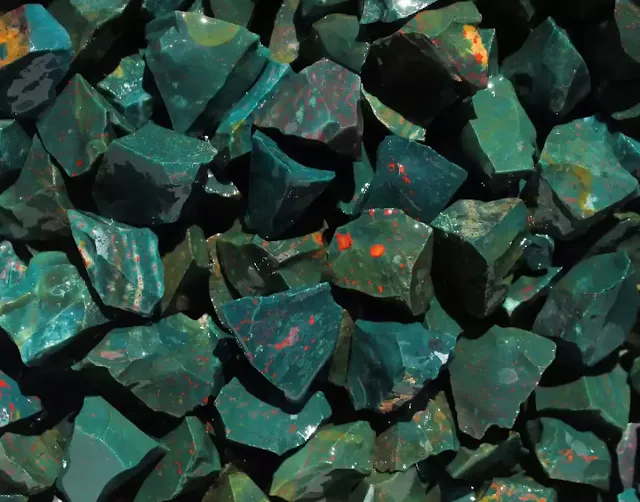Bloodstone: Properties, Facts About it
Bloodstone, also known as Heliotrope, is a type of quartz that is characterized by its dark green color with red inclusions. The red inclusions are typically jasper or chert, and they give the stone its name, which comes from the Greek words for "sun" and "blood."
Bloodstone is a relatively common gemstone, but it is not as abundant as some other types of quartz. It is typically found in small, irregular crystals, but it can also be found in larger, more gem-quality crystals.
In the ancient world it was considered to be a semi-precious
stone or gem, and was used extensively as signet seals and in jewellery,
as well as being carved into decorative cups, small vases and
statuettes.
Heliotrope/Bloodstone Formation
The geological origins of heliotrope/bloodstone are closely tied to volcanic and hydrothermal processes. The formation of heliotrope involves a combination of geological events and conditions that contribute to its unique composition and appearance.
 |
| Bloodstone: Interesting Facts About Heliotrope. A heliotrope, also known as a bloodstone. Photo: Chille Maulidhaa |
Volcanic Activity: Heliotrope is commonly associated with volcanic environments. During volcanic eruptions, molten rock known as magma rises to the Earth's surface or intrudes into existing rocks. The magma can carry various elements and minerals, including silica-rich fluids.
Hydrothermal Activity: When magma cools and crystallizes, it releases water vapor and other fluids into the surrounding rocks. These fluids can be rich in silica and other minerals, which can precipitate out of solution and form new minerals, such as heliotrope.
The specific geological processes and conditions involved in heliotrope formation can vary from one locality to another. Factors such as temperature, pressure, mineral composition of the surrounding rocks, and the duration of hydrothermal activity all contribute to the variations observed in heliotrope's appearance and composition. The geological origins of heliotrope highlight the interplay between volcanic and hydrothermal processes, which result in the unique combination of quartz, iron-bearing minerals, and hematite that give this gemstone its captivating and distinct appearance.
Properties of Bloodstone
The red inclusions are supposed to resemble spots of blood; hence the name "bloodstone". The name "heliotrope" derives from various ancient notions about the manner in which the mineral reflects light. Here are the properties of heliotrope:
Composition: Heliotrope is composed mainly of quartz (silicon dioxide) with the inclusion of green chlorite or amphibole minerals. The green coloration is what distinguishes it from other chalcedonies.
Color: The primary color of heliotrope is green, often with red to brownish-red spots or patches. The red spots are caused by the presence of iron oxide (hematite) inclusions. These distinctive spots are reminiscent of drops of blood, hence the name "bloodstone."
Transparency: Generally opaque due to the presence of inclusions.
Luster: Vitreous to waxy.
Crystal System: Heliotrope belongs to the trigonal crystal system.
Streak: Typically white.
Hardness: 6.5 to 7 on the Mohs scale.
Cleavage: Absent. Heliotrope exhibits conchoidal fracture.
Density: The density of heliotrope ranges around 2.58 - 2.64 g/cm³.
Specific Gravity: The specific gravity of heliotrope is approximately 2.61.
Solubility: Insoluble in water.
Magnetism: Typically not magnetic.
Fluorescence: Heliotrope may exhibit weak fluorescence under UV light.
Pleochroism: Generally not pleochroic.
Refractive Index: The refractive index ranges around 1.53 to 1.54.
Inclusions: Common inclusions in heliotrope include red to brownish-red spots (hematite inclusions) and green mineral inclusions like chlorite or amphibole.
 |
| Rough heliotrope, also known as a bloodstone from Indonesia Photo: Chille Maulidhaa |
Bloodstone Uses
Bloodstone, also known as heliotrope, has been used for centuries for both practical and metaphysical purposes. Here's a breakdown of its various uses:
Jewelry: Bloodstone's beautiful green and red hues make it a popular choice for jewelry. It's commonly used in necklaces, bracelets, rings, and carvings.
Decorative Objects: Bloodstone can be crafted into sculptures, vases, and other decorative items, adding a touch of natural beauty to any space.
Seals & Amulets: Historically, bloodstone was used to create seals and amulets, believed to bring good luck and protection.
Metaphysical Uses:
Healing Stone: Bloodstone has been used in various cultures to promote physical and emotional healing. It's believed to help with blood circulation, detoxification, and overall vitality.
Protection & Grounding: Bloodstone is often used as a protective amulet, warding off negativity and promoting a sense of safety and security. It's also seen as a grounding stone, connecting the user to the Earth's energy.
Emotional Balance: Some believe bloodstone can promote emotional balance by calming anger, reducing stress, and fostering inner peace.
Courage & Strength: Bloodstone is associated with courage and strength, offering support during challenging times.
 |
| Bloodstone |








%20(1).webp)